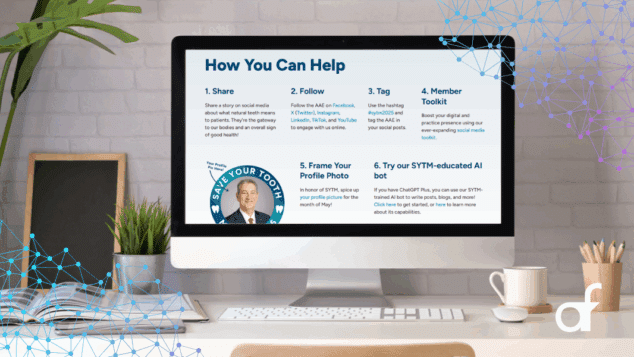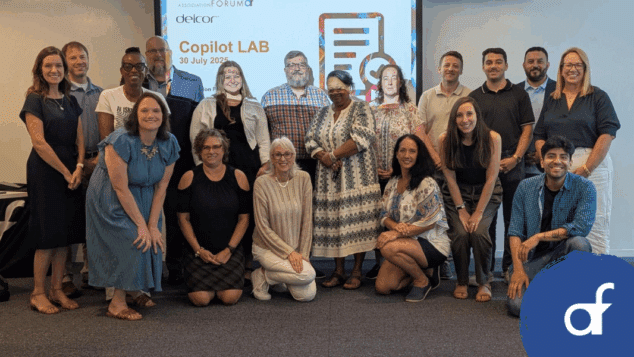A Place at the Table: How IT Governance Can Deliver the Most Value

It’s no secret that decision-makers across the association industry are saddled with the unique challenges of sustaining relevance in an ever-changing business landscape. Particularly vexing are those decisions that have technology components, which is most of them.
The average user is becoming increasingly more sophisticated. Member, staff and volunteer leader expectations for a fast, reliable, personalized experience using intuitive tools correspond to their consumer experience more broadly. Without a clear strategy and effective operational approach to meet these tech challenges head-on, expectations are not met, staff cannot do their best work and goals and objectives fail.
So how can associations best deliver on constituent expectations to avoid such a fate? While a consultative review of the state of technology affairs in your organization might be advisable to gain objective help, all associations are not equipped with the same resources to respond to technology needs in the same ways. It is nonetheless crucial to connect the dots between the broader strategic goals of your organization and what technologies will be necessary to meet them. Effective IT governance, meaning applying a formal framework to ensure IT investments support business objectives, can help you apply a more strategic approach to delivering the technical services your association requires to meet its mission.
A complete IT governance framework should answer key questions such as: How are IT services functioning overall? What metrics does the management team need to validate the return on IT investment? What other potential regulatory and compliance factors should be considered?
There are fundamental practices that you can implement to start down the path to IT governance, ensuring that your efforts are fully understood, well-communicated and support your organizational mission.
A Place at the Table
Historically, organizational leadership and executives deferred key IT decisions to IT management and business leaders. But, technologists’ independent goals may not always be in alignment with the best interests of other stakeholders unless proper oversight is established. IT governance should involve everyone from board members to senior management and support staff. Therefore, it is critical for IT leaders to establish a place at the table in strategy-defining and decision-making groups.
Terry Merkley, VP of Information Technology at the Institute of Food Technologists (IFT) in Chicago, can attest to the benefits of this approach. With more than 12,000 members who produce, package and distribute or research food, IFT’s mission is to advance the science of food and its application across the world’s food systems. “I am a regular participant in the senior management team activities of our organization, so I know about and get to help influence what we consider to be our organizational priorities for any given year,” he says. “When it’s all settled out, the technology projects that we emphasize are those that are most valuable for the organizational strategic objectives.”
This type of participation is vital to support and advance IFT’s objectives. “It’s important to really see what should be done and get people around you to understand it and believe it and look for ways to clear the path and move it forward,” Merkley says. He and his team have been able to deliver significant improvements in the web presence for IFT’s annual event and food expo, their largest source of non-dues revenue. This demonstrates a focus on those elements of business that deliver the most value for technology investment. The most crucial step, however, is in gaining that inclusion in the first place.
For some, the ability to get a seat at the decision-making table may be thwarted by leaders who misperceive the value of the technology voice. Things like infrastructure and maintenance, maintaining an active and appropriate security posture, provisioning and supporting quality user workstations, productivity software and applications support, are in themselves enough to keep a team of technology professionals at capacity. How can you effectively balance those requisite business components with a desire to bring technology to the broader goal-setting conversation? One way is to ensure that your practice in those areas is managed well and to fully understand not only your competencies, but your limitations too.
Jonathan Adams is the IT Director for the Water Quality Association (WQA) based in Lisle, Illinois. With about 2,500 organizational members, WQA primarily represents the sector of the water treatment industry devoted to treating water on the homeowner’s or business owner’s property. Adams is part of the leadership team at WQA, which makes strategy planning decisions “from the point of inception, which is immensely helpful from my perspective. I can’t imagine being handed the strategy and goals for the year for the organization and having to say, ‘How did you get here?’” In that capacity, he is faced with many important decisions about supporting existing systems and processes while allocating appropriate resource time to new objectives. “When I’m looking at new projects, I try to look at how quickly we need this done, how important it is,” Adams says. “Is it a core competency that we’re going to need going forward? Will we need to maintain this knowledge in-house, or is it something we can outsource?”
Regardless of those decisions, Adams says: “There’s one thing that has to happen no matter what. If you’re not keeping the lights on, it doesn’t matter if you have a seat at the table or not, if you’re not running the basic IT business well, that becomes the focus and not the partnership that you need.” Credibility is lost without effective day-to-day technology management. So how do you get there?
Control the Pipeline
One of the biggest challenges any IT team faces is in the management of myriad requests from multiple sources. Enhancing value creation from the IT portfolio requires difficult decision-making about how to allocate finite resources among multiple opportunities.
Applying prioritization to projects is a foundational element of IT governance practice, something that the Higher Learning Commission (HLC) does well, says Norma Castrejon, Associate Director of IT for HLC. Through the work of about 60 staff, HLC accredits roughly 1,000 degree-granting post-secondary educational institutions in 19 different states in the North Central region of the U.S. Castrejon works directly with senior leadership and staff to ensure that the appropriate strategies are prioritized for work to be done and effectively implemented to improve business with technology tools at HLC. “We have some good governance practices in place for our different systems. We don’t just make a decision to implement a new tool or feature because someone asked for it.”
HLC has a governance group comprised of staff users and business line leaders who evaluate requests on a regular basis via a collaborative decision-making process, ranking them according to priority of impact and alignment with HLC goals. “That’s a big thing that IT always fights against, a lot of people who ask for a lot of different things,” Castrejon says. “I’ve seen organized and not-so-organized approaches to this.” But the HLC approach streamlines requests so that focus can remain on delivering those items that address the most pressing needs in alignment with goals.
A single communication channel that formalizes the request and service pipeline can go a long way in achieving a baseline level of control over the request flow. You can emulate this practice by creating a defined team of business users and team leaders who regularly review requests using standardized measurements by which to evaluate their priority. Your prioritization standards will be unique to your organization, and such a process works best when the team you task with this important work is empowered and supported by leadership, but also when the team’s decisions are broadly communicated to stakeholders across the organization.
Break the Whole Into Parts
While controlling the flow of new requests is indeed crucial to the effectiveness of any IT governance strategy, another equally essential element is in deploying active management techniques for those projects you have deemed a priority. Tori Liu, director of information systems for the American Speech-Language-Hearing Association (ASHA), and board member of Association Women Technology Champions (AWTC), applies this concept with her team’s work at ASHA. ASHA empowers and supports over 218,000 audiologists, speech language pathologists, researchers and students nationwide. With a total staff of about 300, ASHA requires an array of systems, products and expertise to deliver on their mission. “Our project request process is very democratic, but also very rigorous,” says Liu.
Once a project is approved for implementation at ASHA, it includes the concept of distinct checkpoints, or stage gates, on the overall effort to approve progress or recalibrate as needed. “It’s important to understand not just what a project will cost to turn up, but what the project will cost operationally to maintain and support once launched,” Liu says. This process of dividing project effort into distinct stages separated by management decision points helps ASHA project teams prepare the right information, with the right level of detail, at the right point to support the best decision possible at each phase of the effort.
It is a risk-limiting governance activity that helps curb project setbacks that might otherwise become costly and out of control. Regardless of the size of your organization or IT resource allocation, you can apply this concept to a meaningful end. Consider plotting the work of your technology projects into segments including requirements, design, development, test and release. Through the completion of each stage, validate inputs with stakeholders to determine whether to proceed to the next phase of the project, allowing your checkpoints to be places at which you may decide to scrap, hold, redesign or proceed with the effort. This concept can be applied to any size effort, and such an approach to even the smallest of technology efforts (moving a physical fax line to a VOIP service, spinning up a third-party support portal, launching an online survey, etc.) will serve your goals.
A Call to Lead
There is no doubt that any association technologist’s calling requires rigor and focus to best serve the needs of the association. Association leaders must recognize this calling by including their technology leaders in decision-making and strategy conversations and support that action by communicating broadly the plans and priorities their work will take to help shape meaningful outcomes. By nurturing practice that efficiently prioritizes service needs and addresses challenging work in manageable phases, you can elevate the IT profile in your organization to continuously bring value and deliver the tools and services the association needs to serve its constituents in the best way possible.
Tags
Related Articles
Turning AI Into Member Value
How AAE’s Save Your Tooth Month GPT became a personalized marketing assistant for members
The Power of Taking the AI Journey Together
Forum’s first Microsoft Copilot Lab brought together 20 professionals to explore how smart adoption of...
Protecting Healthcare: Tackling Cyber Threats to Hospitals and Patients
The critical role of cybersecurity in healthcare and association management.




